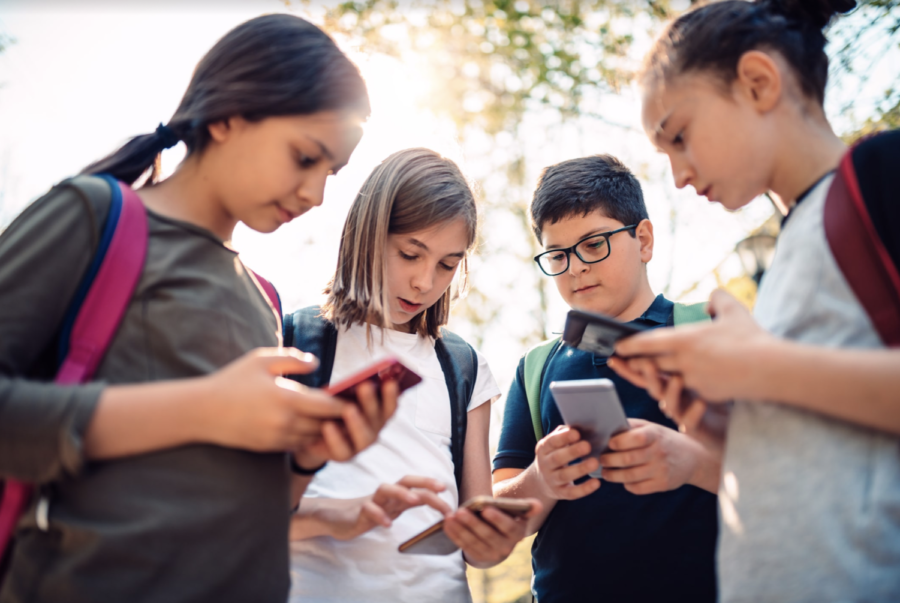The Impact of TikTok on Young Adults
June 8, 2022
The “awkward stage” — as we all know and hate — is a phase of life that ate us up in our pre-teen years and promptly spat us out. Highly influenced by our peers, we sought approval by others with the goal of fitting in. Although body odor, tiny ’staches, and experimental fashion were embarrassing, we could not be faulted because we did not have access to platforms that shared what was socially acceptable. Nowadays, thanks to TikTok, kids between the ages of 9-13 are mimicking the styles and trends of high schoolers, which could be detrimental to their development.
The only thing that middle schoolers want to do is fit in. In attempts to find a community that they can identify with, kids will try just about anything. TikTok offers access to all types of trends and fads that allow kids to feel like they are a part of something. DIY trends, Squishmalllows, slime, and fidget toys are just some examples of trends that exploded within the younger generation due to TikTok. To discover just how influential TikTok is, I sat down with my younger sister, 5th grader Lily Ayers, and asked her about her own experience with the app.
“I spend about 4 hours a day just on TikTok,” said Ayers, “If I see a cool product in videos I’ll buy it and review it myself. I also like to see what clothes people are wearing like Kirsten Titus or Addison Rae.”
The most frequently shopped at stores for tweens, according to Love to Know, are Aeropostale, Hollister Co., American Eagle, and Brandy Melville–stores generally marketed towards teenagers from 13-18 years old. All of which use TikTok to promote their brand to users.
“I primarily shopped at Justice and Khol’s when I was a pre-teen,” said high school junior Mia Bradway, “I wasn’t allowed to wear crop tops or tiny shorts the way that kids today do.”
Mia went on to explain how her childhood — and the childhoods of others her age — was different from the childhoods that young girls are experiencing today: “I was on social media (musically, youtube, snapchat…) for less than an hour per day. I was around 11 years old when I stopped playing with toys like barbies, stuffed animals, and shopkins.”
Bradway believes that kids are growing up too quickly nowadays and it could be detrimental to the current youth: “Middle schoolers look older than me, it’s kinda scary, they have more access to things we didn’t, they see things and mimic them. They won’t be able to self-improve because they can’t compare themselves to an older, worser version of themselves.”
Not only were our middle school years a deeply embarrassing transitional stage, it was also a foundation for us to grow from. It offered a contrast from our past selves to our current selves which is essential for growing up.
The effects
With unlimited, unsupervised access to TikTok and other social media apps, there is bound to be run-ins with inappropriate media. Just the other day, while reviewing ideas for this article, Mr.Cangemi typed in TikTok into his search bar and the very first video that popped up would be deemed too inappropriate for any young kid to see. Middle schoolers soak up this media and must judge for themselves what to do with, or how to use the new information.
Dr. Jennifer Karalekas, resident School Psychologist at Ludlow High for the past 17 years, shared with me her observations of younger students trying to mimic more “mature” trends like clothing styles or activities: “I’ve had the opportunity to do evaluations at Harris Brook and Baird this year and it is very apparent that the styles of young adults is having an impact on the upper elementary grades and middle school students.”
She went on to say “ I see more negative than positive (effects) – addiction to the phone, constantly looking to see how many people looked at posts and approved of them – and feel sad if they don’t get the result they wanted, they worry about what people will say about their posts, FOMO, they have sleep issues, they have difficulty socializing appropriately with peers and adults, even writing can be affected….text and social media language is very different than what is required in school, colleges and places of employment.”
So is the awkward stage really disappearing?
“I’m not so sure it’s disappearing as much as morphing into something else,” said Karalekas. “Just because someone has access to all this information doesn’t mean they know how to process it and figure out what’s real and what’s so staged….trying things, whether it’s on social media or in person, is a part of developing our personalities, who we want to be and ultimately who we become. The lines may be a bit more blurred, but inherently, kids are kids and will always have that “awkward stage” of development. It is from this, in part, that we develop our sense of self.”


